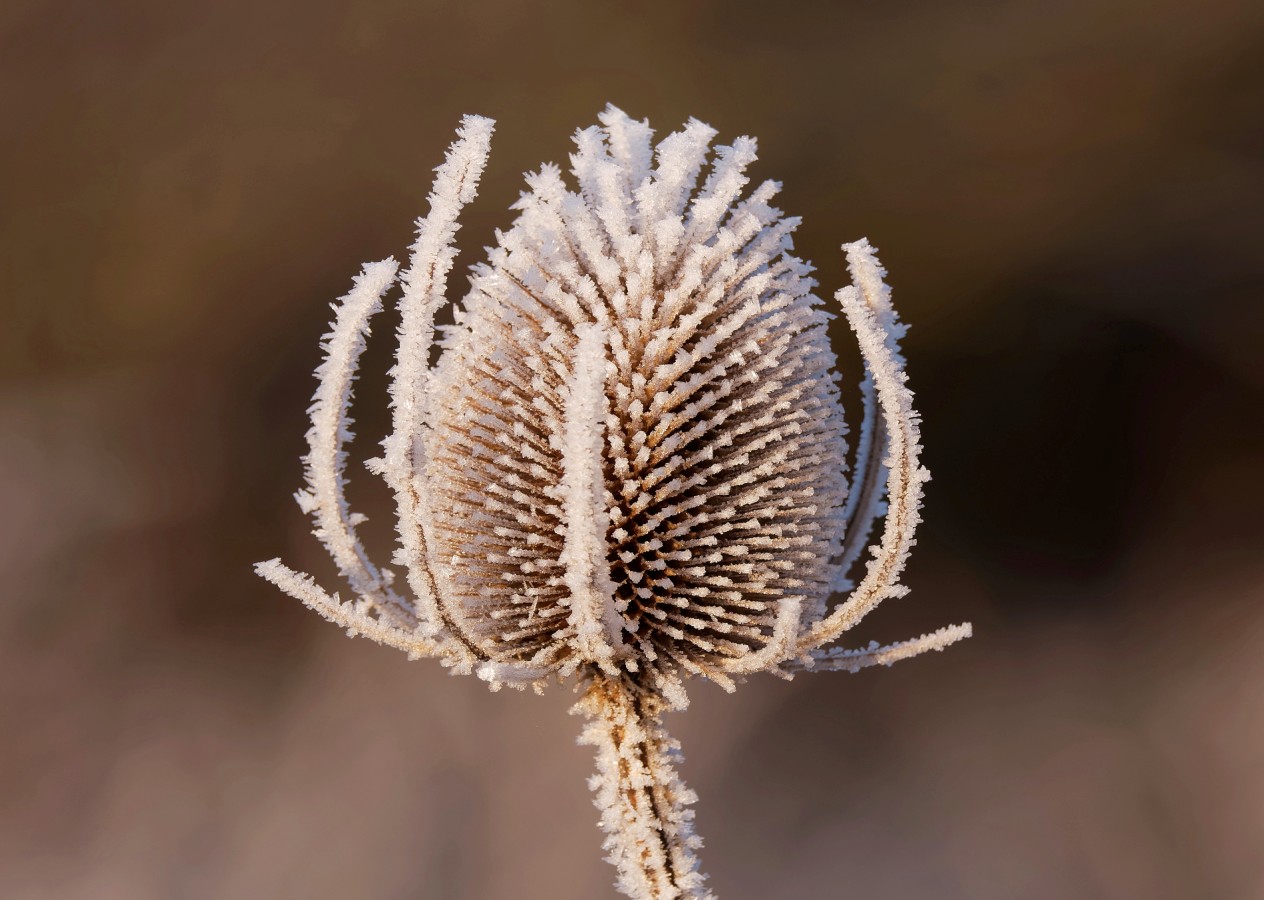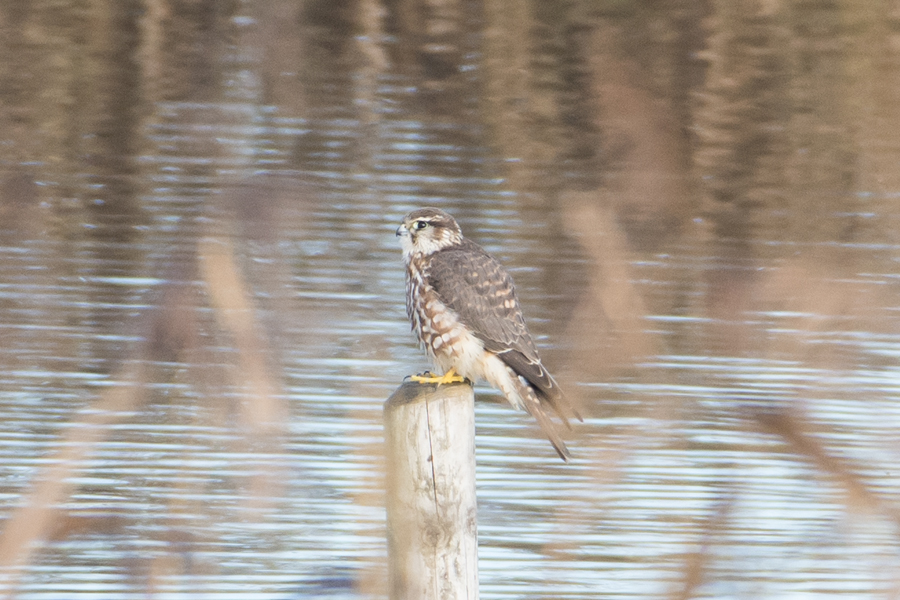Woolston Eyes Monthly Sightings
2019-11-30
A beautiful, sub-zero start this morning, with the lagoon on No.3 bed frozen except for a small pool being kept open by a congregation of wildfowl. A single Woodcock was on the Canal track and, once we settled in the Morgan Hide, we were able to make good early counts, including 1,700 Black-headed Gulls moving east and local feeding movements of 650 Woodpigeons. Redwings were trickling southwards for most of the morning, totalling 420, accompanied by just a handful of Fieldfares. While we were warming up by walking a circuit of the bed a Marsh Harrier flew in and flushed 70 Shoveler, 250 Teal and 25 Gadwall. 95 Pink-footed Geese then flew west and several Water Rails and Cetti’s Warblers were calling. We ended an excellent morning in the Hogg Hide where we were treated to a fly-through Little Egret. Photo of a Goldfinch Cheers David Bowman (with David Spencer, Helen Wynn, Alan Warford and Les Jones)
Submitted by: David Bowman
2019-11-27
A ringing session on No1 bed that started off dry but became showery as the morning went on. Masses of Redwings could be heard moving south before dawn, but as it was too dark to count them, Fieldfares were roosting in the reedbed and a Tawny Owl hunted most of the east side of the bed. A ring-tail Hen Harrier flew briefly over the East Pool before leaving to the east and a Woodcock flew over the ringing station. At dawn approximately 10,000 Starlings left a roost in the centre of the bed.
Submitted by: Eyesbirder
2019-11-20
WeBS Count on 16/11/2019
Little Grebe 5, Great Crested Grebe 4, Cormorant 5, Grey Heron 5, Mute Swan 27, Shelduck 2, Canada Goose 86, Gadwall 64, Teal 340, Shoveler 44, Tufted Duck, 180, Goldeneye 3, Water Rail 5, Moorhen 48, Coot 68,Lapwing 1100, Woodcock 1, Black headed Gull 30, Herring Gull 2
Submitted by: Brian Martin
2019-11-20
Light south-easterlies and clear skies meant a dawn start on No.3 bed, hopeful of a good visible passage. Walking on to the bed a Woodcock flushed from under my feet, with a typical clatter of wings. From the Morgan Hide a Goldeneye was among the commoner wildfowl and a Merlin skimmed across the lagoon. Thrush passage was in full flow from the first moment and the morning ended with totals of 1,800 Redwings and 700 Fieldfares. When things started to quieten down I walked around the bed, where at least 600 more thrushes were feeding on the extensive stands of berry-laden Hawthorn. Finally spent the last hour photographing the common birds at the new feeding station in front of the Sybil Hogg Hide. This brought some surprises too. I was watching a Mouse sp. creeping tentatively around when a Weasel bobbed into sight, briefly. Finally, a Marsh Harrier appeared and gave lengthy views, flushing 600 Teal and 70 Shovelers from cover in the reeds. What a nice morning! Photo of the Marsh Harrier Cheers David
Submitted by: David Bowman
2019-11-18
A Nice cold sunny morning, it was a bit quiet until Daniel Owen spotted a Merlin out on one of the posts it was a bit far for a decent shot so we nipped round to the Tower hide for a better view, managed to get a photo through the reeds
Submitted by: Keith Gallie
2019-11-16
A busy morning, completing the November visible migration count and also conducting the monthly Wetland Birds Survey (WeBS) for the eastern end of the Reserve. As ever, there were birds to be seen en route to the top of Butchersfield Tip, with a Woodcock and 3 Tawny Owls the pick of the bunch. The morning produced some decent passage, with the most notable being: 610 Fieldfares, 175 Redwings, 50 Blackbirds, 200 Pink-footed Geese, 8 Lesser Redpolls, 9 Siskins and 54 Chaffinches. The ones that got away were three distant parties of swans heading towards Martin Mere, which may well have been Whoopers. Although most of the WeBS species are to be found in No.3 bed, Bollin Point, as ever, chipped in with: 2 Goldeneyes, 50 Tufted Ducks, 14 Mute Swans, 12 Gadwall, 14 Teal, 2 Great Crested Grebes, 2 Moorhens and 32 Canada Geese. In addition, 1,100 Lapwings were feeding on fields adjacent to the Reserve. Photo of the view from Rixton Bridge Cheers David Bowman (with Dave Steel, David Spencer, Helen Wynn, Alan Warford and Les Jones)
Submitted by: David Bowman
2019-11-13
A damp morning ringing on No1 bed although 3 Redwings and Cetti’s Warbler were ringed in between the showers. Sightings included a Green Woodpecker, a Little Grebe, 20 Skylarks in one flock and 20 Fieldfares flying south
Submitted by: Eyesbirder
2019-11-09
A sub-zero morning with clear skies and light South-easterly breeze were ideal for a visible migration session. We started at first light in the Morgan Hide and were kept entertained by a steady passage of thrushes and Woodpigeons. The movement lasted until the sky clouded over around 10.30 am. Key totals were: 4,800 Woodpigeons, 830 Redwings, 360 Fieldfares (all heading South-east) and 500 Pinkfeet (heading East). In addition, 3 Woodcocks and 100s more thrushes were feeding around No.3 bed. The link is to a short video clip showing some of the more photogenic species seen from the Morgan Hide during the week. The photo is the dawn view from the Morgan Hide. https://youtu.be/JcC_JKdXeG0 Cheers David Bowman (with David Spencer, Helen Wynn, Kelly Ainsworth, Alan Warford, Daniel Owen, George Dunbar, Brian Baird)
Submitted by: David Bowman
2019-11-07
A very soggy morning on No.3 bed with almost constant heavy rain. The water level has risen well towards our winter maximum and is starting to pull in some diving ducks. After yesterday’s drake Goosander, two female Goldeneyes dropped in, while 3 drake Pochards and 30 Tufted Ducks were present at dawn. The usual spread of common residents included highlights of: 4 Cetti’s Warblers, 3 Willow Tits, 5 Grey Wagtails, 3 Water Rails, 10 Pied Wagtails, 1 Kingfisher, 200 Greenfinches, 100 Goldfinches and 60 Chaffinches. Photo of a Coal Tit Cheers David Bowman (with David Spencer)
Submitted by: David Bowman
2019-11-06
Its been a good autumn on the Reserve, so far, with records in the past four weeks including: Kumlien’s Gull, Little Bunting, Firecrest, Bearded Tits, Hawfinch, Great White Egret, Bittern, Egyptian Geese, Garganey and Jack Snipe. The year list now stands at 152 species, hopefully with more to come. This afternoon offered another minor surprise, when a drake Goosander dropped in to No.3 bed, as they are an uncommon visitor to the Reserve. Other sightings included Willow Tits, Water Rails, Kingfisher, Cetti’s Warblers and small roosts of Starling, Pied Wagtail and Redwing. Record shot of the Goosander Cheers David Bowman
Submitted by: David Bowman
2019-11-02
After the flood of migrants on Thursday, it was more of a trickle today, as a westerly depression slowly moved in. 70 Redwings, 20 Fieldfares and 9 Skylarks were the totals noted. As ever, though, there were plenty of other birds to be found, with a noticeable increase in our common, autumn/winter visitors. As we arrived on the car park a Woodcock flew over our heads and soon afterwards we watched 5,000 Starlings leave a roost in the reed-bed. Greenfinch numbers were at their highest yet, with 230 in a single flock, while other finches included 3 Bramblings, 60 Chaffinches and 50 Goldfinches. Of the resident species, Willow Tit and Cetti’s Warblers were the pick. Cheers David Bowman (with David Spencer, Alan Warford and Brian Baird)
Submitted by: David Bowman

























